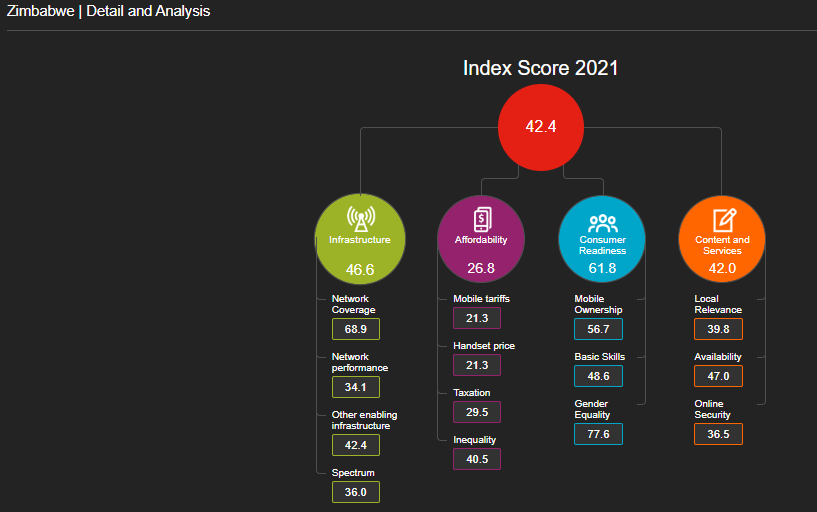By ETimes
Zimbabwe’s mobile connectivity index (MCI) score increased from 29.1 in 2014 to 42.4 in 2021, latest data shows.
The MCI, by the Global System for Mobile Communications Association (GSMA), measures the performance of 170 countries against the four key enablers of mobile internet adoption: infrastructure; affordability; consumer readiness; and content and services.
The index is built up through 41 indicators feeding into 14 dimensions that are aggregated to give a score for four enablers. Scores fall within a range of 0–100.
The southern African nation’s 2G coverage remained flat at 93.44% in 2021 when compared to 2020. Accordingly, 3G coverage increased to 99% while 4G coverage was up to 50%.

Every business in the world has to deal with overheads like utilities, security, and general service and maintenance. But this is Zimbabwe and as such, some of these overheads are a much bigger cost than outside of Zimbabwe.
Persistent national grid power outages continued to adversely affect network availability.
This is an expensive source of energy, which is made worse by the fact that fuel is priced in US dollars but telecom companies receive the majority of their income in local money.
Businesses are accelerating the installation of solar power solutions to minimise the usage of already installed diesel-powered generators, which are costlier to run and maintain. Like any other business, the full impact of cost increases is passed on to the consumer, resulting in the internet being so expensive in Zimbabwe.
However, Zambia’s MCI score improved from 21 in 2014 to 41 in 2021, making it the most improved country in Sub-Saharan Africa (SSA) over the period.
This success is due to infrastructure advancements, operator investments, and accessibility, according to GSMA.
Between 2014 and 2021, Zambia’s 2G coverage rose from 78% to 98%, and it is currently practically universal. While 4G coverage increased from 9% to 69% during the same time frame, 3G coverage increased from 38% to 82%.
“1 GB of data now costs less than 2% of monthly GDP per capita, compared to more than 10% in 2014, demonstrating Zambia’s efforts to achieve the ‘1 for 2’ affordability target,” reads the report.
“The cost of an entry-level device has fallen from more than 50% of monthly GDP per capita in 2016 to less than 20% in 2021, as a result of cheaper smartphones and smart feature phones, including the MTN Ka Toffee smart feature phone, which is priced at less than $20.”
The report noted that the coverage gap declined from 19 percentage points in 2020 to 17 percentage points at the end of 2021 as a result of ongoing mobile broadband expenditures in the area. On the other hand, SSA still has the biggest coverage and usage gaps despite this development.
Within SSA, large regional differences are concealed by overall trends. In 2021, the coverage gap was 12% in Southern Africa and 39% in Central Africa.
The GSMA said the difference between 3G and 4G coverage will only be 25% in 2021, down from 45% in 2017.
According to the report, SSA still has the lowest average cost of data, even if the cost of 5GB has increased there.
“In 2020, SSA was the only region where affordability of handsets improved. But in 2021 it has remained broadly flat,” it said.
“SSA is the only region where the cost of 1GB of data as a percentage of monthly GDP per capita exceeds 2%.” – Harare


